The following are a list of impressive houses with a great historical past in Ireland.
Powerscourt House & Gardens 
The glorious formal gardens at Powerscourt, which boast stunning views of the Sugar Loaf Mountain, is one of the County Wicklow’s best loved attractions.
The gardens, spanning 47 acres, began when the house was built for Richard Wingfield between 1731 and 1740. A century later the 7th Viscount Powerscourt decided to expand the family fortunes with the creation of an elaborate garden.
It’s certainly worth a visit and features include well-maintained gardens, sweeping terraces, ornamental lakes, picturesque walks as well as walled gardens. And for the nature lover among you there are over 200 different species of trees and shrubs. Powerscourt House & Gardens is open to the public.
Fota House, Cork 
The demesne of Fota, or Fota Island, contributes enormously to the beauty of the Lee Estuary whose sublimity moved Lady Chatterton to write in 1838; ‘the sun always seems to shine brighter here than else where’. Fota’s magnificent parkland, its gardens and splendid mansion - one of Ireland’s finest regency houses - combine to create an aura of charm and serenity apparent to all who visit.
Fota’s former owners, the Smith-Barrys, were direct descendants of Philip de Barry, a Norman settler who was granted lands in cork in 1179.
Their great estates were later ruined by the reckless gambling of ‘Hellgate’, the seventh Earl of Barrymore, but Fota was unaffected by this debacle for it had earlier been given to Arthur, third son of the fourth Earl. His eldest son John, who inherited the property in 1801 had a rather different attitude to his Irish home. John had a passion for sailing and from an early age preferred to live at Fota where he could race with the Royal Cork Yacht Club.
In 1983 the house was exquisitely redecorated by John O’Connell with Irish furniture and fittings to complement the Woods collection and was opened to the public.
It is now managed by the Fota Trust who closed the building to the public at the end of 1990, due to the deterioration of its structure.
Muckross House, Gardens And Traditional Farms 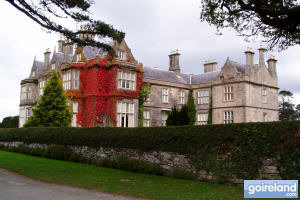
Listed among the top tourist attractions in Ireland, situated in the heart of the beautiful Killarney National Park and found close to the shore of Killarney’s lower lake is Muckross House, one of Ireland’s largest stately homes.
Built in 1843, Muckross House was the epitome of a typical 17th century mansion. Then in preparation for Queen Victoria’s visit in 1861, some elaborate renovations were made, making the house the wonderful spectacle that it is today.
Today the rooms that you can see are furnished in period style and expose the elegant lifestyle of the 19th century landowning class, the houses last residents. When you come to the house you can also see the servants living quarters, which are, located deep down in the basement.
The house itself is surrounded by beautiful gardens and is an ideal place to go for a walk! Admire the houses fine collections of azaleas and rhododendrons, its extensive water garden, and an outstanding rock garden made out of limestone.
When in Killarney town, look for the Muckross Road which is the N71 road to Kenmare. Muckross House is well signposted on this road - it’s about 4km from the town on the right hand side.
Coole Park & Gardens, Gort, Galway 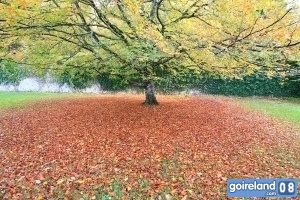
Coole Park is the former home of Lady Augusta Gregory, a great friend of W.B. Yeats and co-founder of the Abbey Theatre. It’s located about 3km north of the county Galway town of Gort and is operated by the National Parks & Wildlife Service. It spans about 1,000 acres and includes 6km of nature trails, 7 woods and of course Coole Lake.
Coole House, since demolished, was a focal point in the Celtic Literary Revival at the turn of the century. The initials of notable visitors to Coole House can be seen on the famous Autograph Tree.
This tree on which Lady Gregory invited her literary guests to carve their initials, is now the centre of attraction of the great walled garden in the Nature Trail at Coole Woods. The initials gently fade with passing time, but with a little effort, you can still make out the flamboyant style of George Bernard Shaw among the more cryptic carvings of J.M. Synge, Augustus John, An Craoibhin Aoibhinn (Douglas Hyde, first President of Ireland).
The Customs House 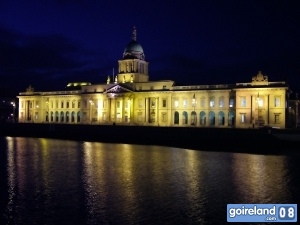
The Custom House, designed by the renowned James Gandon, was completed in 1791 and is one of Dublin’s finest heritage buildings. It has played a unique role in Dublin’s social, economic and political history over the past 200 years.
The Visitor Centre is located in and around the Dome or Clocktower area which contains the most important interior features to have survived the destruction of the building by fire in 1921, during the War of Independence.
The Centre includes a Gandon Museum with information and displays on his life and work in Ireland; the history of the Custom House itself, including the 1921 fire and subsequent restoration and on the many Government offices and important characters who have office in the building in the 200 years.
Killruddery House & Gardens Wicklow 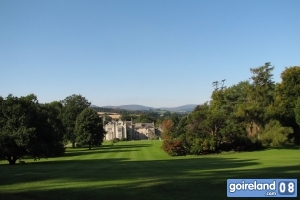
Killruddery House has been the home of the Brabazon family (the Earls of Meath) since 1618. It was completely renovated in 1820 by the 10th Earl. The large and small drawing rooms have particularly fine plasterwork ceilings. There’s an Orangery, which was added in 1852, and the house is surrounded by magnificent gardens that date back to the 17th century.
A number of Hollywood movies have been ‘on location’ at Killruddery House including My Left Foot, Far and Away and Becoming Jane. The production The Tudors was also shot on location here.
Visitors can take a guided tour of the house and take a stroll around the well-maintained gardens during the open season.Killruddery House is situated at the front of the Little Sugar Loaf Mountain 1.5 km from the centre of Bray on the Greystones Road.
Lissadell House, Sligo 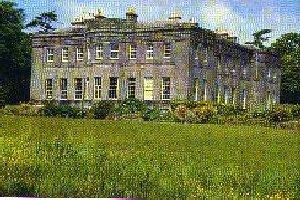
Lissadell - “That old Georgian Mansion” in the words of W.B. Yeats - is situated 13 km north of Sligo off the Sligo/Bundoran road.
It is still owned by the Gore-Booth family. A fine but austere example of Greek-Revival architecture, it is full of many artefacts associated with succeeding generations of the family. Visitors can expect a genuine atmosphere of faded grandeur.
The bow windows of Lissadell House look across Sligo Bay. William Butler Yeats recalled them in his poem to the Gore-Booth sisters Eva and Constance, Lady Markievicz. “The light of evening, Lissadell. Great Windows, open to the South”
The Gore-booths have lived at Drumcliffe for centuries and the present house, built near a previous castle and manor, by Sir Robert Gore-Booth in the 1830′s, is still their home. Lissadell holds the legacy of generations of colourful Gore-Booths including the travel diaries of Sir Robert who mortgaged the estate to help the poor during the famine. His son Sir Henry sailed to the rescue of the Arctic explorer Leigh Smith.
The dining-room walls are painted with overlife size figures of the butler, forester and gamekeeper by her husband Count Casimir Markievicz. At the core of the house is a dramatic two storey hallway lined with Doric columns leading to a double staircase of Kilkenny marble.
Swiss Cottage, Cahir 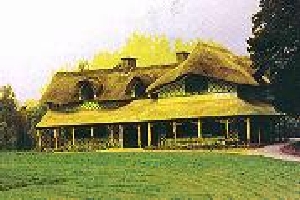
A delightful “cottage orne” built in the early 1800s by Richard Butler, 1st Earl of Glengall to a design by the famous regency architect John Nash. Its interior contains a graceful spiral staircase and some elegantly decorated rooms. The wallpaper in the Salon, manufactured by the Dufour factory, is one of the first commercially produced Parisian wallpapers.
It’s situated on an elevated site with access by stone steps. Access is by guided tour only, videos/cameras are not permitted on tour. Please note this is a very busy site and visitors may experience a delay during the summer months.
To get to Swiss Cottage, enter via Cahir Wood, off the Ardfinnan Road, R670.
